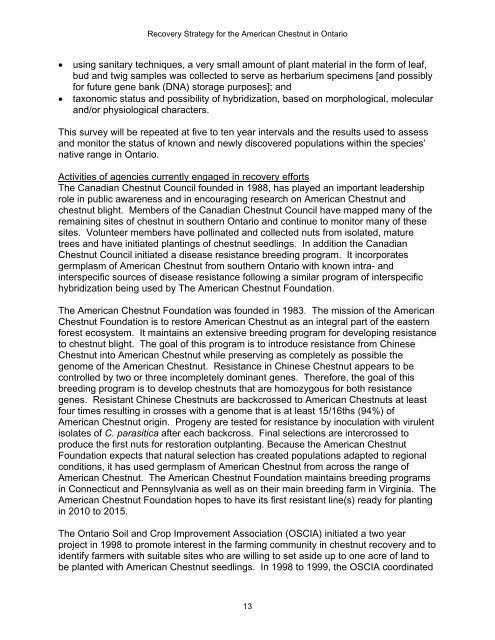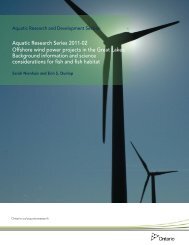(Castanea dentata) in Ontario - Ministry of Natural Resources ...
(Castanea dentata) in Ontario - Ministry of Natural Resources ...
(Castanea dentata) in Ontario - Ministry of Natural Resources ...
Create successful ePaper yourself
Turn your PDF publications into a flip-book with our unique Google optimized e-Paper software.
Recovery Strategy for the American Chestnut <strong>in</strong> <strong>Ontario</strong><br />
<br />
<br />
us<strong>in</strong>g sanitary techniques, a very small amount <strong>of</strong> plant material <strong>in</strong> the form <strong>of</strong> leaf,<br />
bud and twig samples was collected to serve as herbarium specimens [and possibly<br />
for future gene bank (DNA) storage purposes]; and<br />
taxonomic status and possibility <strong>of</strong> hybridization, based on morphological, molecular<br />
and/or physiological characters.<br />
This survey will be repeated at five to ten year <strong>in</strong>tervals and the results used to assess<br />
and monitor the status <strong>of</strong> known and newly discovered populations with<strong>in</strong> the species’<br />
native range <strong>in</strong> <strong>Ontario</strong>.<br />
Activities <strong>of</strong> agencies currently engaged <strong>in</strong> recovery efforts<br />
The Canadian Chestnut Council founded <strong>in</strong> 1988, has played an important leadership<br />
role <strong>in</strong> public awareness and <strong>in</strong> encourag<strong>in</strong>g research on American Chestnut and<br />
chestnut blight. Members <strong>of</strong> the Canadian Chestnut Council have mapped many <strong>of</strong> the<br />
rema<strong>in</strong><strong>in</strong>g sites <strong>of</strong> chestnut <strong>in</strong> southern <strong>Ontario</strong> and cont<strong>in</strong>ue to monitor many <strong>of</strong> these<br />
sites. Volunteer members have poll<strong>in</strong>ated and collected nuts from isolated, mature<br />
trees and have <strong>in</strong>itiated plant<strong>in</strong>gs <strong>of</strong> chestnut seedl<strong>in</strong>gs. In addition the Canadian<br />
Chestnut Council <strong>in</strong>itiated a disease resistance breed<strong>in</strong>g program. It <strong>in</strong>corporates<br />
germplasm <strong>of</strong> American Chestnut from southern <strong>Ontario</strong> with known <strong>in</strong>tra- and<br />
<strong>in</strong>terspecific sources <strong>of</strong> disease resistance follow<strong>in</strong>g a similar program <strong>of</strong> <strong>in</strong>terspecific<br />
hybridization be<strong>in</strong>g used by The American Chestnut Foundation.<br />
The American Chestnut Foundation was founded <strong>in</strong> 1983. The mission <strong>of</strong> the American<br />
Chestnut Foundation is to restore American Chestnut as an <strong>in</strong>tegral part <strong>of</strong> the eastern<br />
forest ecosystem. It ma<strong>in</strong>ta<strong>in</strong>s an extensive breed<strong>in</strong>g program for develop<strong>in</strong>g resistance<br />
to chestnut blight. The goal <strong>of</strong> this program is to <strong>in</strong>troduce resistance from Ch<strong>in</strong>ese<br />
Chestnut <strong>in</strong>to American Chestnut while preserv<strong>in</strong>g as completely as possible the<br />
genome <strong>of</strong> the American Chestnut. Resistance <strong>in</strong> Ch<strong>in</strong>ese Chestnut appears to be<br />
controlled by two or three <strong>in</strong>completely dom<strong>in</strong>ant genes. Therefore, the goal <strong>of</strong> this<br />
breed<strong>in</strong>g program is to develop chestnuts that are homozygous for both resistance<br />
genes. Resistant Ch<strong>in</strong>ese Chestnuts are backcrossed to American Chestnuts at least<br />
four times result<strong>in</strong>g <strong>in</strong> crosses with a genome that is at least 15/16ths (94%) <strong>of</strong><br />
American Chestnut orig<strong>in</strong>. Progeny are tested for resistance by <strong>in</strong>oculation with virulent<br />
isolates <strong>of</strong> C. parasitica after each backcross. F<strong>in</strong>al selections are <strong>in</strong>tercrossed to<br />
produce the first nuts for restoration outplant<strong>in</strong>g. Because the American Chestnut<br />
Foundation expects that natural selection has created populations adapted to regional<br />
conditions, it has used germplasm <strong>of</strong> American Chestnut from across the range <strong>of</strong><br />
American Chestnut. The American Chestnut Foundation ma<strong>in</strong>ta<strong>in</strong>s breed<strong>in</strong>g programs<br />
<strong>in</strong> Connecticut and Pennsylvania as well as on their ma<strong>in</strong> breed<strong>in</strong>g farm <strong>in</strong> Virg<strong>in</strong>ia. The<br />
American Chestnut Foundation hopes to have its first resistant l<strong>in</strong>e(s) ready for plant<strong>in</strong>g<br />
<strong>in</strong> 2010 to 2015.<br />
The <strong>Ontario</strong> Soil and Crop Improvement Association (OSCIA) <strong>in</strong>itiated a two year<br />
project <strong>in</strong> 1998 to promote <strong>in</strong>terest <strong>in</strong> the farm<strong>in</strong>g community <strong>in</strong> chestnut recovery and to<br />
identify farmers with suitable sites who are will<strong>in</strong>g to set aside up to one acre <strong>of</strong> land to<br />
be planted with American Chestnut seedl<strong>in</strong>gs. In 1998 to 1999, the OSCIA coord<strong>in</strong>ated<br />
13
















